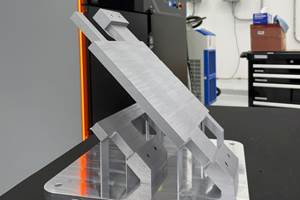The Additive Manufacturing Process: How Much Data is Enough?
In proving out a new AM material or process, a supplier accumulates data valuable for internal development and customers’ needs. At what point is there enough data for customers to make confident decisions?
Share
Editor’s note: This article is the second in a series on additive manufacturing process verification composed by Michael Hayes, a former AM leader at Boeing and current ADDvisor for The Barnes Global Advisors. In his previous position Hayes qualified and produced hundreds of polymer AM parts for the aerospace industry. Read the first article here. — Stephanie Hendrixson, Executive Editor
Tensile bars, tensile bars and more tensile bars. If you are a current or aspiring aerospace AM part producer, you must be asking, “How many more tensile bars do I have to pull?” If you are bringing to market a new AM material, a new AM process or perhaps both, then chances are you have been building a ton of these simple “dog bones.”
 Photo credit: The Barnes Global Advisors
Photo credit: The Barnes Global AdvisorsYou have been gathering data internally to improve your material and/or process and for your initial data sheet. Once you have gone to market and started attracting potential customers to your material and/or process, one of the first things your potential customer asks for is MORE mechanical property coupons. They seem to not be too interested in all the data you have already collected. They want more, sometimes, lots more. You would not be the first to ask, “How much data is enough?”
The Seventh-Inning Stretch
It’s only a bit of a stretch to relate this to the great sport of baseball — call it a seventh-inning stretch. Baseball is simple, yet complex, much like additive manufacturing. In its simplicity, a baseball team wins an individual game by scoring more runs than the opposing team. So, the question is, “How many runs do you need to win a baseball game?” The answer is simply, one more than the opposing team. Relating back to AM, the simple answer to the data question is that you need just one more data point than your customer’s engineering group wants.
But here is where the simplicity stops and the complexity begins. The number of runs needed to win a game is based on many variables; macro variables include available players, weather, opponent and even the ballpark, and micro variables narrow down to the specifics of a single pitch. Similarly, there are many variables in AM processing that affect the mechanical properties — both macro variables, such as the printing process, the material or the type of machine, and micro variables such as the material batch, the particular machine or the cleanliness of energy. So, we can determine that the amount of data needed is based on an understanding of the variables, chief among these are the customer and the application of the AM parts.

Playing by the Rules
Another parallel between scoring runs in baseball and collecting data in AM is the requirement to play by the rules. To score a run in baseball, the rules require the player to physically touch each base in a particular order. Similarly, the data for AM must follow the rules, a proven process done in a particular order. In the first article of this series, “The Additive Manufacturing Process: An Expectation of Consistency,” we addressed the importance of having a sound material and process specification prior to generating the mechanical data; the specifications should be addressing the micro variables of both the material and process and demonstrating the stability and repeatability of the technology.
A recent article from my colleagues at The Barnes Global Advisors, Kevin Slattery, D.Sc. and Jennifer Coyne, titled “Order of Operations in Metal Additive Manufacturing,” documents the necessary order of operations in AM production, a handy tool anyone can use to determine if a solid process is being followed. There are many ways to generate data, but if the provider is not following the rules, then the data becomes suspect and we start from scratch.
Show Me the Stats
Another parallel to baseball is in the capability of AM to generate statistics. Even though runs cannot be used from one baseball game to another, the statistics of the run generation can be very valuable to help determine strategies and player lineups for future games, not to mention future salaries.
Within AM, the same can hold true. When working with a new customer or application, the provider may have data to share, but in most cases, new data will also be requested. It is not to say the preceding data is useless. It will provide guidance, but the new customer or new application may require a whole new set of environmental conditions or engineering requirements that need to be tested. Or, there may be a new set of specifications, in which case all new data is required, unless there can be some agreement to bridge testing. But all this data can be statistically utilized for allowables, or creating mechanical property values that have a certain level of confidence to which the engineer can design. In the next article, we will elaborate on the confidence of AM produced hardware and whether getting to aircraft certification is possible.
The Closer
A famous quote from the movie Bull Durham stated,
“This is a very simple game. You throw the ball, you catch the ball, you hit the ball. Sometimes you win, sometimes you lose, sometimes it rains.”
To win in AM, you must play by the rules and generate an endless stream of statistics. The good news is, just because the data generation process never stops, it does not stop your material, your machines and your parts from being shipped around the world and into all sorts of great applications. Most likely, every time you revise the hardware or software of the machine or improve your material, more tensile bars will be required. The reality is, there will never be enough data — right up until that material or equipment is set to retire. For baseball, like AM data, every day is a new game and a new opportunity to score runs and collect stats.
About the Author

Michael Hayes
A recent addition to The Barnes Global Advisors, Michael Hayes is the principal ADDvisor on polymer and composites for the group. He previously spent more than 34 years with McDonnell Douglas/Boeing in structural design and additive manufacturing (AM). For the past two decades, he technically and strategically led the evolution of polymer AM from rapid prototyping into aerospace production through the engineering of material and process developments, requirement definitions, application selections, qualifications, testing, certifications, and technology transitions. Hayes’ AM knowledge and strategic direction helped Boeing become a leader in the implementation of polymer AM, and his technologies have been utilized across the global Boeing enterprise making him the advisor and consultant he is today. He was the Boeing team leader in the founding of America Makes on the original governance board and a key founding representative of the Direct Manufacturing Research Center (DMRC) in Paderborn, Germany. Hayes holds 15 U.S. patents with two pending. He has a Bachelor of Science degree in aerospace engineering and a Master of Science degree in mechanical engineering, both from the University of Missouri-Rolla.
Related Content
What Does AM Want? Here Are 4 Aims (Maybe 5) That Additive Manufacturing Is Driving Toward
Certain freedoms and contributing factors allow additive manufacturing to realize its full promise for production.
Read MoreDecentralized Manufacturing Network Aims to Make 3D Printers a Shared Global Resource
The 3DOS additive manufacturing network will let OEMs and creators take advantage of open 3D printer capacity anywhere in the world.
Read MoreFor Production AM, Is Metal a Better Candidate Than Polymer?
Taking stock of the many AM successes we have covered on The Cool Parts Show, and what the breakdown by material type reveals.
Read MoreThe Arrival of the AM Factory: How Proprietary Processes Deliver Production 3D Printing
Various recent articles report on companies using internally developed technology to equip factories and deliver on the promise of AM for production.
Read MoreRead Next
The Additive Manufacturing Process: An Expectation of Consistency
In production additive manufacturing, producing good parts isn’t enough. Understanding the full fabrication process is the first step toward controlling it and ensuring ongoing consistency in the end-use parts.
Read MoreCrushable Lattices: The Lightweight Structures That Will Protect an Interplanetary Payload
NASA uses laser powder bed fusion plus chemical etching to create the lattice forms engineered to keep Mars rocks safe during a crash landing on Earth.
Read MoreBike Manufacturer Uses Additive Manufacturing to Create Lighter, More Complex, Customized Parts
Titanium bike frame manufacturer Hanglun Technology mixes precision casting with 3D printing to create bikes that offer increased speed and reduced turbulence during long-distance rides, offering a smoother, faster and more efficient cycling experience.
Read More



















